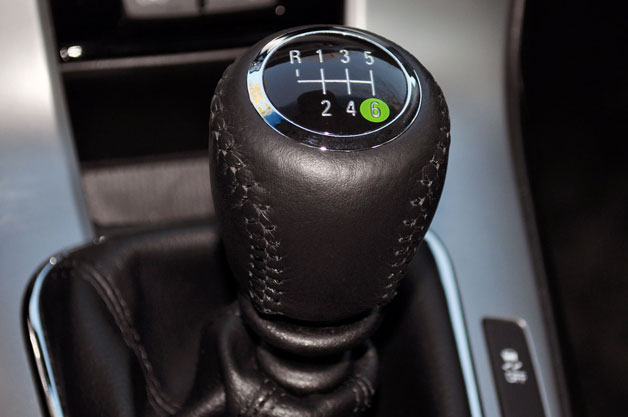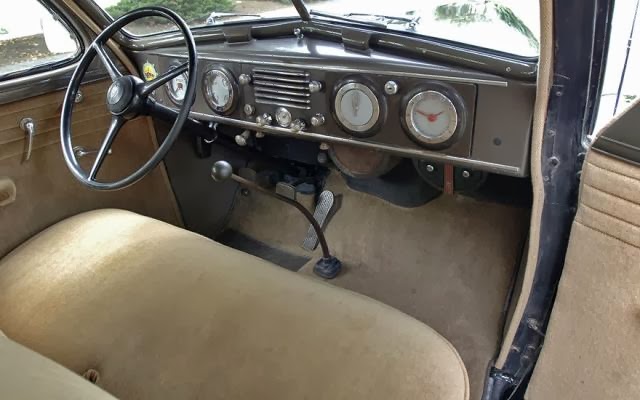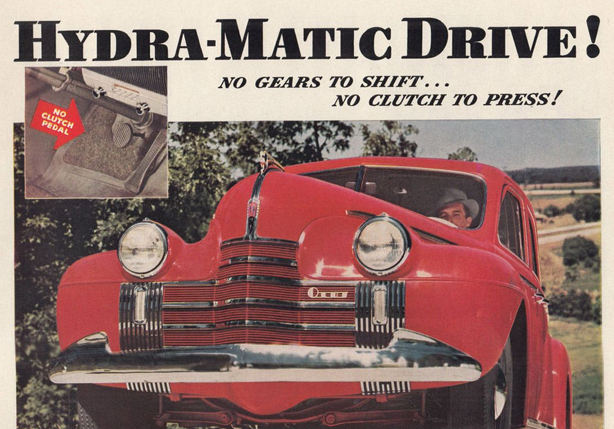
Diagram on the gear lever of a modern six-speed “stick shift” auto- mobile shows location of the vehicle’s various gears, which require that the driver depress a clutch pedal on the floor in order to shift.
AUTOMATIC TRANSMISSIONS
TAKE FUN OUT OF DRIVING
AND DECREASE CONTROL
‘Stick shift’ vehicles are quickly disappearing
from U.S. roads, becoming relics of the past
By David Maril
Boasts of 100 miles per gallon, if cars and trucks are still using gasoline, have been predicted for the not too distant future.
Futuristic improvement designs for all-electric, partially electric, solar battery, and everything but wind-driven highway vehicles are either being perfected or formulating.
For several years Chevrolet has been promoting a car called the “Volt,” which runs either completely — or almost completely, depending on what definition you go by — on electricity.
Toyota made quite a name for itself getting the jump on the high mileage hybrid market first. Other carmakers had to play catch-up but they all have their own versions of extravagantly priced models that will save you money at the gas pumps.
Producing these low-energy cars with motors that don’t pollute the atmosphere is a great accomplishment. Maybe, in the next few decades, we will finally become energy independent as a nation and be able to shape a more reasonable and realistic approach to our foreign policy.
There is, however, one major downside to these noiseless vehicles. And it’s the reason why I will never own and drive anything but cars and trucks that run on traditional gasoline.
Much to my dismay, all of these vehicles of the future are equipped only with automatic transmission. All of this modern technology will soon render standard-shift cars obsolete.
I continue to wonder why with all the innovations in technology, it’s asking too much to design an electric car that has gears needing to be shifted.
And this is a shame. The ultimate driving experience calls for shifting gears that go with manual transmission.

Three-speed “stick” on the floor of a 1937 Oldsmobile. Note front “bench” seat, which made shifting difficult when three people were sitting abreast.
Take a car, truck or SUV with standard shift out for a spin and you feel the control and sense of satisfaction being able to fine-tune your car’s handling and traction. When you are up-shifting or down-shifting, you become part of the car’s operating system, participating in the technical process of running the engine.
Your senses are more closely connected with how the car is performing, your speed, and the total driving experience.
This is in drastic contrast to these new silent, electric-type vehicles that seem more related to push-button golf carts than cars. Some make so little noise, there’s a safety concern that pedestrians aren’t able to hear them coming.
It’s been getting harder and harder to find standard-shift vehicles for a number of years. The so-called premium or luxury cars dropped the shifting option decades ago.
Standard shifts in trucks, buses and heavy SUVs have disappeared faster than bottle openers. Jeep had the audacity to bring back a line of SUVs called Cherokees this year without even offering manual transmission as an option. When was the last time anyone saw a new American-made pickup truck with a clutch?
Car dealers insist automatic transmissions translate to elimination of costly clutch and transmission repairs because too many drivers don’t know how to effectively shift gears. They also contend that advances in computer technology with automatic transmissions make them more fuel efficient than standard shift.
Some car manufacturers have even come up with a phony gear option, letting you shift into low or second without a clutch, and some vehicles have as many as five “gears.” But that’s a far cry from the control of standard transmission.
It doesn’t replace the driving skill you need when stopping and starting on a hill, coordinating clutch and accelerator so you don’t stall out. It also isn’t a substitute for the safety control you gain down-shifting on snow and slippery road conditions to slow down and reduce wear and tear on the brakes.

Console-mounted Volkswagen stick shift is far cry from the iconic “four on the floor” of late 1940s through 1970s vehicles that were so popular in those days.
Several years ago I took a five- speed manual transmission Honda Accord with 30,000 miles on it in for service. When I picked the car up, the service agent pulled me aside and said, “Hey I have to ask you something. Do you use your brakes at all? They look brand new, as if they have hardly been used.”
The explanation was simple. If you downshift properly when slowing down or coming to a stop, you don’t need a lead-foot on the brakes.
To me, it’s hard to believe that you can no longer buy a full-sized Ford or Chevrolet with standard transmission. Who’d have ever thought Jeep, the traditional off-road vehicle, would only offer standard shift on a few models in the Wrangler line?
In the old days, people who bought pickup trucks were looking for durability in carrying heavy material around. Ford truck owners reveled in the roar of the machine-gun-sounding manual transmissions.
Chevrolet “stick shifts” had the familiar milk-truck whining, almost melodic, transmission sounds. Today, most pickup trucks are fashion statements with power windows, leather seats and generic sounding engines.
Sports cars are on a similar fast-track to no-shift routes. This seems to defy the whole concept of driving a flashy souped-up car.
You can still get a six-speed shift with cars like Mustangs. But who knows how long that will last? Most sports cars offer both automatic and standard but I will never understand why anyone would even consider buying a Corvette without manual transmission.
For now, most of the “foreign” cars, like Toyota, Honda and Subaru, offer the last vestiges of standard shift. But the trend is even shifting away to automatics with these fuel-efficient vehicles. One Honda dealer told me that on the Civic and Accord, the percentage of new standard-shift cars sold has dropped under 30 percent.

Diagram of Hudson Jet gearbox outlines location of gears known colloquially as “three on the tree.” (Hudson was a popular vehicle of the 1930s-’50s, long since out of business.)
No matter how much favorable publicity high-mileage automatics receive, I’ll bet drivers with standard shift have better safety records. Besides having more control of the car, your focus is more on driving.
With a clutch and gearshift, you need two hands to steer and shift, cutting down the opportunities to juggle a cup of coffee and a smartphone while maneuvering one-handed through traffic.
Automatic-transmission advocates will emphasize there are too many cars on the road these days and more traffic jams. Even a standard-shift fanatic will admit it’s a chore if you are stuck in 10 miles of summer Bay Bridge traffic backups and you end up with a sore left leg from repeatedly lifting your foot off and on the clutch.
But that’s an extreme situation.
The truth is that drivers who have never driven standard don’t know what they are missing. There’s a feeling of being in control on even the most slippery road surfaces. Unlike automatic transmission, in snow you can downshift and slow down while reducing the chances of skidding.
Looking on the bright side, if you are a diehard like me and still have a standard shift car, you should be able to make a case for lower insurance rates. It has to be a fact that manual transmission cars are harder to steal. How many car thieves do you think even know how to drive cars with clutches and gearshifts?
Just last week in Baltimore, for example, would-be car thieves broke into a vehicle that had a five-speed stick and didn’t know how to drive it, thereby saving the owner a lot of aggravation trying to get her car back.
One inside note on this subject: If your manual transmission car is stolen, there’s a good chance the crook is a newspaper person.
A few years ago a bunch of us at a newspaper I was working at were talking about the demise of standard shift. And much to my surprise, a quick survey found that all seven of us, editors, columnists and reporters, all drove standard shift cars.
Talk about a specific group of people marching to their own drumbeat, or being out of touch with trends!

“Hydra-Matic” was the name given to automatic transmission cars by General Motors upon their inception in the late 1930s-early 1940s. Shown here is an advertisement for a 1940 Oldsmobile, one of the first such vehicles on the market. The absence of a clutch pedal was revolutionary.
Despite newspaper people, who, for whatever reason, remain unusually attached to manual transmission, times have changed.
How many people even remember when most Maryland drivers, with their standard shift cars, took part of their driving tests stop- ping and starting, going up Federal Hill? The drivers had to demonstrate that they’d mastered the art of going from brake to clutch and gas petal without stalling and rolling backward on the steep incline.
Oh yes, there is one final favorable point of a gearshift car. If you are continually being pestered by friends or people in your family wanting to drive or borrow your car, they won’t even bother to ask if you have manual transmission.
davidmaril@voiceofbaltimore.org
“Inside Pitch” is a weekly opinion column written for Voice of Baltimore by David Maril.
EDITOR’S NOTE: The term “stick shift” typically applies to non-automatic, “manual” transmissions in cars and trucks that require the driver to depress a clutch pedal in order to shift gears.
It has progressed since the early 1900s from three speeds on the floor of the vehicle to “three on the tree” — a manual transmission with the shift lever mounted on the steering column — to “four on the floor” (made popular by the original Volkswagen “Beetle”), and now five or six gears with the lever on the vehicle’s floor or console.
The new “semi-automatic (SAT)” transmission — also know as “flappy-paddle gearbox” or “paddle-shift gearbox” — is a clutchless manual transmission that facilitates gear changes by the driver without the need to depress a floor pedal at the same time as changing gears.
It differs markedly from a “stick shift” and does not provide comparable driver control of the vehicle.
CHECK OUT LAST WEEK’S “INSIDE PITCH” COLUMN: click here
…and read archived Dave Maril columns by clicking here.






June 29th, 2014 - 11:25 PM
OK, OK, we get it! You like your stick!
But, as a driver of all things with wheels (yes, even the old steering column manual tranny) – and also a driver of several electric vehicles – it is very clear to me you have NEVER driven an electric car, or ridden an electric motorcycle. With all due respect – you have no idea what you are talking about. An EV has much more ‘control’ at all speeds. The clutch and tranny are not omitted as some kind of plot against manual transmissions – they are simply not necessary as the electric motor stays in it’s power/torque band at all speeds. The lack of distraction (when to upshift, when to downshift, etc.) is huge advantage for focus and safety – quite the opposite of what you wrote.
Try one before you condemn them!
June 30th, 2014 - 10:30 AM
And Hell’s Angels Harley-hogg bikers love Hondas and Suzukis… Yeah right!
July 5th, 2014 - 8:04 PM
[…] Voice of Baltimore by David Maril. CHECK OUT LAST WEEK’S “INSIDE PITCH” COLUMN: click here …and read archived Dave Maril columns by clicking here. […]